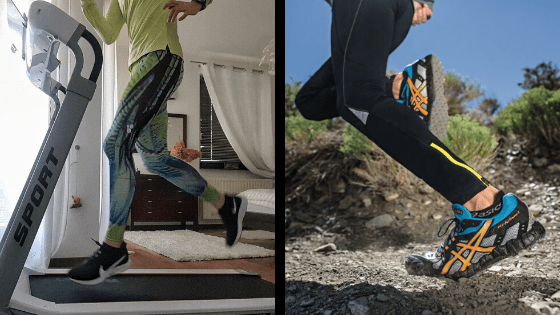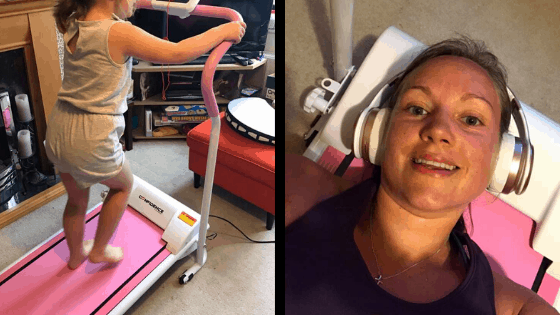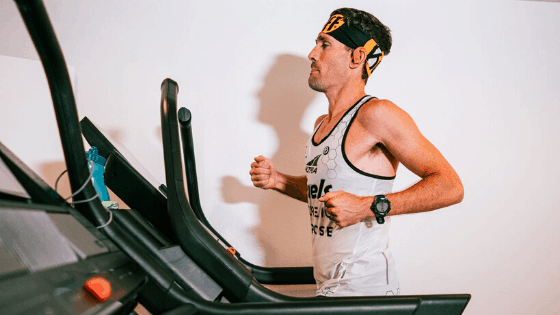
My first time running on a treadmill was somewhat unnerving. How to pace myself, and keep my footing without falling off. Dawid, my exuberant cocker spaniel, and running mate, was watching on, panting excitedly, tail wagging.
Dawid badly wanted to join in on the fun but was immediately overcome by suspicion. Is this some kind of sneaky trick? Long story short, once Dawid got the hint that he was receiving cheers and treats for managing the rolling path (bells and whistles and all), he was hooked. Only two things could distract him: food and those magic words, “Let’s go to the park.”
It begs the question: which is better – trails or treadmills? Let’s find out.
Which is better: trails vs treadmills? Scientists love treadmills. They create a controlled and accessible environment where it is easy to measure and analyze an athlete’s data for specific criteria. However, no treadmill can emulate the extent of mental health benefits that the same athlete will get from being in nature, out on the trails.
The repetitive movement of running on a treadmill has the risk of injury that puts you at danger of joint or ligament damage, whereas, the unpredictable surfaces of trails strengthen your ligaments and stimulate more muscles, improving your body balance plus your overall mental wellbeing.
Treadmills Growing in Popularity
Treadmills have become one of the most popular pieces of fitness equipment in our homes and gyms. For both the city dweller stuck in the concrete jungle as well as for the athlete waylaid by bad weather, the treadmill is the “to go to” as part of their fitness training.
Come to think of it, who needs trails if you can virtually enjoy the same experience on the treadmill without going through the schlep of first having to assemble yourself and then get to the trail, often a time-consuming exercise. Jumping onto a Treadmill in the room next door is so much simpler, better, and faster, right?
Or is it really?
Let’s investigate, given the fact that both trail and treadmill running have their own benefits. Let’s weigh up the pros and cons so as to ensure that you’re knowing what you’re getting yourself into and make sure that you’re taking good care of your mental and physical health while feeling good.
But first, let’s have a look at where and how the story of the treadmill started before it became this cutting edge technology piece of equipment that has taken over our homes and gyms today.
The First Treadmills
The use of the conveyer belt ‘science’ behind the treadmill was known to ancient civilizations, going as far back as ancient Rome. As a matter of fact, treadmills were introduced long before the development of powered machines.
Treadwheels as they were known back then, were used to harness the power of animals or humans to do the work, often a type of mill that was operated by a person or animal treading steps of a treadwheel to grind grain.
The action of treadwheels – both rotary and reciprocating – was used with light machineries like butter churns, grindstones, fanning mills, and cream separators to produce food and keep the family fed.
But there’s also a darker side to treadmills when in later years, they were used as punishment devices for people sentenced to hard labor in prisons. We’ll get back to this point on “punishment” a bit later, but, first, let’s look at the science behind the treadmill.
The Science behind Treadmills
The treadmill is basically a conveyer belt that utilizes mechanical rollers to move the belt at a predetermined speed. Most treadmills have a hydraulic system where the angle of the belt can be adjusted.
Most treadmills have a “cardio mode”, where a target heart rate is defined and the speed and elevation (load) are controlled automatically until the subject is in “heart rate steady state”. So the treadmill is delivering mechanical energy to the human body based on the vital function (heart rate) of the subject.
Another common treadmill feature is an interval training mode where speed and elevation vary at regular and irregular intervals that are designed to mimic what you encounter out in the real world.
Energy Expansion
How much energy does it take? Running up and down trails or ramping it up on the treadmill? Personally, I find treadmill running way less energy-sapping but more much more monotonous. The uneven tracks and wind resistance outdoors let you use up more energy, getting you closer to your fitness goals faster.
However, a 1996 study conducted by Exeter University, under Prof. Andrew Jones, proved that runners running on a treadmill could compensate for the extra energy a runner expends while running on outdoors by just putting the treadmill to a 1% gradient.
Absence of Visual Prompts
Another dimension to look out for when doing the comparison between treadmill and trail running is the speed of running.
It’s seen that people running on a trail run much faster than on a treadmill, even though the runner thinks otherwise. The reason for this isn’t absolutely known but running slower indoors could be attributed to the absence of visual prompts, which help you work harder outdoors.
What is Safer – Trail or Treadmill Running
Sure, running trails by its very nature, could pose a risk of injury but running indoor on a treadmill has its own risk: the injury caused by the repetition of the same movement.
Repeating the same movement puts you at the danger of joint or ligament damage, also known as “overuse injury”.
Trail running on the other hand, given the unpredictable and jagged surfaces, strengthen your ligaments and stimulate more muscles, improving your body balance.
Moreover, the biggest difference is the effect running in natural environments has on your general well-being.
It is especially known to giving a greater sense of revitalization and positivity, decreasing depression, uplifting mood, and boosting clarity of thought. This makes running on trails more enjoyable and worthwhile.
How to avoid Overuse Injury on Treadmills
By mixing up your treadmill running with some speed and inclination variations will help in reducing this risk.
Most treadmills have a feature where you can choose from a series of interval workout sets. In each of these interval workouts the speed and inclination of the treadmill change at preset times during the workout.
It will be these variations that will help you to avoid the type of overuse injuries that come from only ever running at one speed on one surface.
Benefits of Running on Trails
I’m lucky. I step out of my front door and have some awesome trails right on my doorstep. Trails that enable me to run over extensive distances with large uphill and downhill elevation for a good couple of hours without ever getting bored. For example, the 200-mile Sulayr circular trail passes by where I live.
In short, trail running gets you OUT. Out of the humdrum of daily life and away from mental clutter and back into nature and the ever-changing landscapes to help restore your sense of being human. Of being alive. Other than just a being a “hamster on the wheel” so to speak.
For instance, just the other morning, while out on the trail, I encountered an Ibex mountain goat, peacefully gracing just a couple of feet away. I wanted to take a picture, but she walked away from social media fame. For some strange reason, it made me feel happy.
But hey, don’t take my word for it. Let’s find out what the “science” has to say about the benefits of trail running and if it can match my own “feel good” moment on the trail.
These were the key points covered by the Sports Medicine review article that was published in August 2016:
1. Cognitive and Emotional Benefits of Trail running
According to scientific studies, trail running indeed gives you a chance to disconnect from the urban fast-paced life and the greater room to breathe. It gives a sense of freedom that helps in lowering neural commotion in a region of the brain linked with cerebral disorders.
Lots of science, but stay with me. Let’s get to the bottom of this, OK?
The study goes on to state: This “sense in freedom” helps in reducing rumination and breaking free from the vicious cycle of negative thoughts that could turn in depression and other mental illnesses. It also helps us to get rid of perplexity, rage, and depression.
“It seems that there is something about physical activity outdoors, in a natural setting, that decreases worry, anxiety, and other negative thoughts,” states Greg Bratman, principal author of the report. He added about the new fMRI technology, “We could actually see these changes in the brain. It was fascinating.”
Moreover, Bratman’s findings imply that trail running, in particular, proves to have a greater benefit.
“Leaving the busyness and tumult of the city for more natural settings seems beneficial when it comes to psychological wellbeing,” he articulates. “A trail run may offer something [for mental health] that urban running does not.”
2. Physical Benefits of Trail running
In general, both uphill and downhill running can have a negative impact on your hips, ankle, and knees, but more so on the knees. I covered this in greater detail in my article Is trail Running Better for your Knees. Be sure to check it out for tips to save your knees.
Uphill running has the effect of shortening your stride because the gradient comes up to meet you so much quicker. Although uphill running is more physically taxing, it is the least damaging to your joints in terms of impact forces.
Conversely, during downhill running, the leg extensor muscles are experiencing high eccentric load as explained in the study published in the British Journal of Sports Medicine.
At the same time, there is an increased shock load through the legs that is up to five times body mass on each stride.
Therefore, trail running is an excellent strength training workout.
3. Fresh Air and Lung Health
Running on the road or in any other urban region will still have you dealing with traffic in some way or the other which means the air would have some level of pollutants in them. But running on trails gives you an exceptionally high amount of fresh air which you can’t find elsewhere.
4. Trail Running and Mental Health
Any type of working out will cause your body to produce endorphins that help you feel calmer. This is true whether you are pounding the pavement, using a treadmill or out on the trails. All of these options will give you a burst of these happy chemicals.
Certainly dodging traffic and being surrounded by a wall of noise tends to be a bit of a buzz kill and can easily destroy this newly found sense of serenity. This is likely why so many urban runners plug music into their ears.
Being able to run on trails gives you unparalleled seclusion from mundane noises and disturbances.
Trails just have a way of closing off the rest of the world and all of the chaos,”
Dr. Jerry Lynch – psychologist and author
Dr. Jerry Lynch of Duke University, a psychologist, recommends trail running as a treatment modality to his patients who suffer from depression.
“I’ve had several clients over the years who were depressed and taking medication and it wasn’t working. I steered them toward trail running and they became more at peace with themselves and found joy.”
Dr. Jerry Lynch – psychologist and author
Did you know? Some treadmills have loud motors and make lots of noise that can interfere with other activities near the equipment, including your mind…
“Trail running is quiet and contemplative.”
Dr. Jerry Lynch – psychologist and author
Benefits of running on the Treadmill
Now let’s cover a few points on treadmill exercises. Treadmills provide you the opportunity to exercise in the convenience of your own home.
They are easy to use and you can do a variety of exercises on a treadmill. Nowadays you can hook your phone or tablet to your treadmill and do various workouts and even get into virtual racing.
People who run outside and run on the treadmill can tell this difference immediately that running outside demands more of your body.
There are a couple of disadvantages that come with running outside, including for beginners. For instance, you might slow down because of fatigue and land up far from home with no energy to get back home.
Then there is the dreaded bad weather. Though, when it comes to bad weather, I remember a friend that when asked what happened if it starts raining while he was out on his daily run he would always answer the same: “Then I get wet.”
Treadmills allow you to exercise at your home no matter what weather. Maintaining your desired pace while exercising is extremely important, and you can achieve that on a workout done on a treadmill. Below are some benefits of running on a treadmill.
1. Preventing injury while keeping track of your heart rate
The surface on a treadmill is padded which decreases the impact on your legs and protects you from injury. For those who are overweight or might have knee problems can run on a treadmill without too many complications.
When you run on a treadmill, you reduce the risk of tripping because treadmills have a predictable surface, unlike sidewalks, trails, or curbs.
With that said, I have tripped on a treadmill but not fallen. On one of my first treadmill runs in the gym, someone came to talk to me and stood in front of the treadmill. To better heat what they were saying I moved forward and my one foot landed on the solid part of the treadmill in front of the belt.
If you want your heart and lungs to receive the most benefit from a workout, you must maintain their heart rate at the proper intensity level for whatever type of workout you are doing.
Treadmills make it easier to monitor heart rates. Treadmills nowadays include built-in heart rate monitoring systems that enable you to track your progress, this way you could get the most out of a workout in a healthy and safe manner.
My most common type of heart rate related training that I do on the treadmill is my Maffetone type training sessions where I set my maximum heart rate within my aerobic limit for maximum fat burning.
Living in the mountains it is impossible to run outside without going uphill and having my heart rate spike. Therefore the only way I am able to run on the flat and keep my heart rate down in the target range for my Maffetone-Method training sessions is by doing them on a treadmill.
2. Cardiorespiratory function and Quality of Life
A group of scientists joined forces with a World Health Organization group to test the impact of treadmill aerobic exercises on pulmonary hypertension and quality of life in patients.
For the duration of the study, the participants were sorted into a ten-week education only program or education/exercise combined program.
The exercise program consisted of 24 – 30 sessions of treadmill exercise for 30 – 45 minutes per session at 70% to 80% of your maximum heart rate. There were 23 women from the ages of 54 to 65 who were randomized into these groups.
Following the ten-week program, the participants that were in the education/exercise group demonstrated an improvement in “time to exercise intolerance” and a “six minutes’ walk time” test.
Additionally, this group scored better on all tests on the education part of their program. In contrast, no significant improvement was seen for any of the outcome measures following the educational group. The women who exercised on a treadmill showed good signs of the quality of life.

It is interesting that the WHO study limits their findings to a narrow range of stating that walking on a treadmill has a positive crossover effect on educational performance.
What I have found both in my own life and the lives of those who I have coached is that exercise will have that effect in general because a person who exercises regularly will be both more fir and have greater energy levels and hence cope with the demands of their education better.
This crossover effect is even greater in those instances where the physical exercise is something where the participant breaks through the upper limit of what they thought was possible. My theory on this has been that when you lift the lid of an upper limit in one aspect of your life, you will tend to increase the upper limit in other aspects of your life at the same time.
That is why the finish line of an event is such a transformative process for anyone who completes that event. It is even more so when that event is their first time at a new distance.
3. Benefits for Diabetic Patients
According to a study published by the Indian Journal of Clinical biochemistry regular exercises decreases body blood sugar levels in people with Non-insulin–dependent (type II) diabetes.
A treadmill is a perfect way to encourage people to exercise regularly. Doing regular exercise is very important in controlling the insulin levels present in type 2 diabetic patients.
The combination of diet and exercise is the best way to control diabetes symptoms in patients that are not insulin-dependent. It is ideal though to consult a doctor before starting their exercise routine because an exercise that is too intense can result in rising of blood sugar levels.
And doing exercise of 20 minutes or less causes the liver to release stored glucose for energy, but a session that is more than 20 minutes is beneficial because it causes the glucose to be released as fuel for the muscles and lowers the overall blood glucose levels.
A regular exercise on a treadmill can allow patients to lower their blood glucose enough so that their medication can be adjusted or eliminated. Regular workout on a treadmill can also help in controlling the hormones that induce sleep and provides better sleep.
As you can see from the study of love that there are benefits to both working on a treadmill and running on a trail. A smart runner has to take the necessary precautions before deciding to choose to exercise on these options.
It’s a good idea to mix these both options in a workout routine some days running on the trail troops to be more beneficial done running on a treadmill and the same can be said for the treadmill.
In the case of chronically obese patients, it has been shown in clinical trials that the use of an Alter-G (anti-gravity) treadmill has major benefits as these treadmills have the ability to massively reduce the impact forces that an obese person would generate while walking or running on a standard treadmill.
In Summary: Treadmills are convenient and provide a straightforward, efficient aerobic workout. For many, treadmills are a good choice to start off with when they start a new exercise routine.
Walking on a treadmill is well tolerated by most people regardless of fitness level. It also a good start for anybody returning from injury as a rehabilitation tool. As both strength and endurance are developed, the treadmill can be used for jogging and/or for interval training.
Boredom to Hell
However, the single biggest disadvantage of running on a treadmill is the mind-numbing boredom that comes from the lack of visual stimulation i.e. changing landscapes and fresh air.
Keep running the treadmill day in and day out like a hamster on the wheel, trust me, it can do a number on your mind after a while. Made worst by looking at your pale and gaunt face staring back at you in the mirror, as a result of lack of sunlight and fresh air, hell no!
Time to Get Out
From my own experience, trail running is still a far more motivating reason for getting out of bed.
Back, when I was at my low point while going through some serious shit and major life changes, getting out into nature quite literally saved my sanity. We had a trail to the top of a nearby hill that would take around 45mins to climb. Every morning I would pick up a single pebble from the riverside at the bottom of the hill, carry it up with me and build a little pile of river pebbles at the top at the rate of one pebble a day.
But what if you can’t get out? What if you’re told you are not allowed to go out and must stay under lockdown for an unspecified time?
Huh?
Yes, it’s real!
Are Treadmills the Future of Fitness Training?
During the spring of 2020, the sales of treadmills shot up by a staggering 400%, a mere five months before the start of the ill-fated 2020 Olympics!
It will go down in history as the time the world as we knew it, changed forever. Athletes around the world had to resort to running on treadmills (some on stationary bikes) to keep up their fitness in preparation for the Olympics, which sadly, was not to be.
We were “locked down” and confined to our homes/apartments for weeks on end with nowhere to go. It begs the question:
Will treadmills become the future of our fitness training and if so, will the science behind treadmills be able to give us everything we need – both physically and mentally – to compete at optimum levels?
With the disruptions that the crisis of spring 2020 brought to Life as We Know It, we have to wonder about normality: when will things “return to normal,” and if so, what will a “new normal” look like? Are we set for a new revolution in our sport with virtual racing?
Zwift Virtual Racing: The New Normal
For the three of you that maybe don’t know what Zwift is, let’s first look at that in a bit more detail.
At first glance Zwift is an online gaming platform. However, that is perhaps a little too simplistic. What sets Zwift apart from other online gaming platforms is that it requires real-world physical effort to move your virtual-world character in the game.
Zwift started out as a cycling only platform but has now expanded into running as well.

The platform has already passed 550.000 subscribers at the start of 2018 and is easily double that by the start of this year. The worldwide lockdown that happened during the spring of 2020 caused a huge surge in Zwift subscriptions.
This surge in subscriptions has created the cash flow that has enabled Zwift to finance a professional racing season for cyclists and triathletes in the absence of any other available racing.
The running side of the Zwift platform has been set up as a way to interact with other runners in a virtual world in much the same way as the cycling part of the platform started. Even today the biggest part of the cycling platform remains training and specific fitness tests.
It is a matter of time before Zwift running expands to include more racing and even professional running events into their eSports program. The remaining challenge to overcome is the issue of treadmills seldom having identical calibration. Professional cycling events overcome this by the athletes having 3 different sources of power data that the platform can use in cross-calibration. Running is not quite there yet.
Using Zwift makes running inside fun. I used to hate using a treadmill, but now that I have a virtual community to run in, I love that I am able to interact with people from all over the world.
Gwen Jorgensen – Professional runner and 2016 Olympic Triathlon Champion
But will it keep us SANE?
WARNING: The Darker Side to Treadmills and Virtual Racing
No, it’s not about tripping and falling off—
Or maybe?
But it most definitely about when you don’t know when to stop.
You get so carried away regardless of the dangers.
Obsession, Madness.
Especially when you under lock down and stuck inside for weeks on end.
One day more on the treadmill is one day less on the trails.
Hey, guys STOP, keep calm and carry on by reading this: How to Taper for your Goal Race either now, or during your next treadmill workout.

Let’s set the science aside for a moment and close out with a couple of bullet lists about whether or not you really need a treadmill in your life.
Advantages to Using a Treadmill
- Treadmills are convenient and relatively easy to use at home if you’re savvy enough to assemble the parts otherwise just join the Gym.
- Treadmills allow you to control all aspects of your workout according to your fitness requirements, meaning it can fit all sorts, from being the lazy slob or the pain in the ass fitness obsessive that you are.
- Treadmills have all the bells and whistles that come with special features such as step counters and heart rate monitors to enable you to track your fitness progress, for those of you who are serious about your form.
- Treadmills have a predictable surface that is much easier to negotiate than trails and the risk of tripping is reduced unless you fall asleep from boredom or have a cocker spaniel hell-bent on joining you.
- Generally, you can design custom programs to fit the time you have to exercise, especially for those of you who don’t know when to stop (see The Dark Side of Treadmills)
- If you stuck inside due to bad weather or lockdowns and worry about your weight, running on a treadmill generally burns calories faster than most other forms of in-home exercise.
- While on the treadmill, you can do other activities such as watch television or read, which can help to alleviate boredom due to the lack of visual stimulus.
- A treadmill allows you to simulate the climate conditions of your goal race. Like Lionel Sanders did when training in icy Canada for the Ironman in hot, humid Hawaii – he set up his treadmill in what was effectively a sauna.
Disadvantages to Using a Treadmill
- Be prepared to fork out some serious money because treadmills don’t come cheap, with some models over $2000.
- If you live in a tiny bachelor’s flat or small space, you may have to sleep on your treadmill because they can take up a lot of space. They’re bulky and generally do not fold up very small.
- Also keep in mind, this big and noisy piece of machinery may at some stage stop running when you least expect it. Like any other equipment with computerized programs and motors, maintenance of treadmills usually requires a professional of sorts.
- Speaking of “noisy” – it is true that some treadmills have loud motors that can interfere with other activities near the equipment.
- The cushioned surface of the treadmill may still inflict too much of a jarring impact on the back or stress the hip, knee, and ankle joints. Testing the surface and rebound is critical.
- Treadmills provide a limited kind of exercise – walking to running – so some people find treadmills boring after a while.
Title photo credit: Agnieszka Binasik

Very interesting and detailed comparison, Eduardo. I would always prefer running in the natural environment because it’s more stimulating and makes me feel happier: the unpredictability of the trail, encounters with other runners, cyclists, wildlife, etc. To me a treadmill just seems an inferior and expensive substitute, with the real risk of falling off. If I can’t get out for any reason (lockdown, weather, specific running impact injury, etc.), I’d much rather use a different type of exercise machine to build up my fitness while introducing a bit of variety (in my case I have a rowing machine, but a spinner would also do).